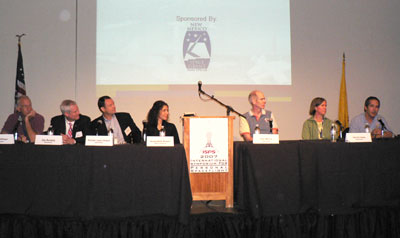
Above: a panel of space travelers discuss the spaceflight experience on Thursday afternoon. From left: Jeff Hoffman, Jay Buckey, Michael Lopez-Alegria, Anousheh Ansari, Dan Barry, Janice Voss, and John Herrington.
The second and final day of the International Symposium for Personal Spaceflight started off with a focus on spaceports (actually, it started off with a flamenco dancing demonstration, but that’s another story), and later turned its attention to the financial issues associated with NewSpace and closed out with a panel of government and commercial space travelers. Some highlights:
- Olle Norberg of Spaceport Sweden, in what was billed as the first public appearance (at least in the US) from an official of that planned spaceport, said that they are currently in the midst of a feasibility study for the facility, located at the Esrange sounding rocket launch site in northern Sweden, that is scheduled to conclude at the end of next year. If all goes well the spaceport could be open to Virgin or other operators in 2011-2012. One challenge: working through a tangled regulatory landscape that is not as well-defined as in the US.
- Turning to local spaceport issues, work is underway on the environmental assessment for Spaceport America in New Mexico. Officials here hope that the assessment is completed by September, which would allow a groundbreaking perhaps at next year’s conference. (The assessment is also required for the spaceport to get an FAA license.) The current schedule calls for Spaceport America to open in April 2010.
- Many communities in southern New Mexico, from Las Cruces to small towns like Hatch, are looking to the spaceport as a big driver of economic development for the area. One speaker said the spaceport was going to be the biggest economic benefit for southern New Mexico in 20 years.
- One issue in the area has been a sales tax (officials, “gross receipts tax”) that will help fund the spaceport. (Those taxes will contribute $60 million to the spaceport, with the state paying the rest of the $200-million cost of the facility.) Doña Ana County, which includes Las Cruces, passed the tax earlier this year, but two other counties, Sierra and Otero, have yet to hold their own referenda on the tax. Lori Montgomery, mayor of Truth or Consequences, NM, said Sierra County will likely hold a referendum on the tax in March or April of next year, after “educating” the citizens about the tax.
- A search for a new executive director of the New Mexico Spaceport Authority is winding down, and the office plans to make an announcement by early November. Kelly O’Donnell, the current acting executive director, said the office plans to ask the state for a four-fold budget increase in 2008 to help staff up the office.
- Alex Tai, at the end of a general presentation about Virgin Galactic, said that the company had booked $31 million in sales so far, the largest figure announced by the company to date.
- Lov Levin of t/Space said he wanted to challenge the “myth” that this was a new market: instead, he argued, we are in the midst of a transition from a government-dominated market to a commercial one, which may make it easier for potential investors to better grasp the opportunities.
- Janice Voss, who left the astronaut corps a few years ago to work on NASA’s Kepler mission (she plans to return at the end of this year, but not in a flight capacity), said when she left she looked at the opportunities in the commercial market when she left but couldn’t see where the market was going. If she was leaving now, she said, it would be a different situation, with many more opportunities.
- John Herrington, a former NASA astronaut now working for Rocketplane, said that he expects a wave of retirements from the astronaut corps when the shuttle program ends, particularly among those who don’t expect much of a chance to get the limited flight opportunities once Orion comes online. These people, he said, will certainly look at opportunities in the commercial sector.
- Understatement of the day: Chuck Lauer, filling in for George French on a panel about how NewSpace companies have adapted to the changing market, about the K-1 saga: “Obviously there are challenges we are working through.”

I actually consider the second to last point a negative. One of the allures of the New Space industry for me was the idea that maybe it would become possible for more people to fly in space. But if the market gets flooded by ex-astronauts, it’ll just be another ten or twenty years of putting the same people in orbit, just under a different logo.
I’m not discounting their capabilities, and it’s obviously in the best interest of the companies to hire people with experience. Just disappointing.
By the way, I have probably the only public video of the X-Racer tests. I’ll send you more info tomorrow.